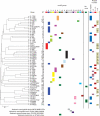Haemophilus influenzae phasevarions have evolved from type III DNA restriction systems into epigenetic regulators of gene expression
- PMID: 17675301
- PMCID: PMC1976455
- DOI: 10.1093/nar/gkm571
Haemophilus influenzae phasevarions have evolved from type III DNA restriction systems into epigenetic regulators of gene expression
Abstract
Phase variably expressed (randomly switching) methyltransferases associated with type III restriction-modification (R-M) systems have been identified in a variety of pathogenic bacteria. We have previously shown that a phase variable methyltransferase (Mod) associated with a type III R-M system in Haemophilus influenzae strain Rd coordinates the random switching of expression of multiple genes, and constitutes a phase variable regulon--'phasevarion'. We have now identified the recognition site for the Mod methyltransferase in H. influenzae strain Rd as 5'-CGAAT-3'. This is the same recognition site as the previously described HinfIII system. A survey of 59 H. influenzae strains indicated significant sequence heterogeneity in the central, variable region of the mod gene associated with target site recognition. Intra- and inter-strain transformation experiments using Mod methylated or non-methylated plasmids, and a methylation site assay demonstrated that the sequence heterogeneity seen in the region encoding target site specificity does correlate to distinct target sites. Mutations were identified within the res gene in several strains surveyed indicating that Res is not functional. These data suggest that evolution of this type III R-M system into an epigenetic mechanism for controlling gene expression has, in some strains, resulted in loss of the DNA restriction function.
Figures



Similar articles
-
The phasevarion: phase variation of type III DNA methyltransferases controls coordinated switching in multiple genes.Nat Rev Microbiol. 2010 Mar;8(3):196-206. doi: 10.1038/nrmicro2283. Epub 2010 Feb 8. Nat Rev Microbiol. 2010. PMID: 20140025 Review.
-
DNA sequence repeats identify numerous Type I restriction-modification systems that are potential epigenetic regulators controlling phase-variable regulons; phasevarions.FASEB J. 2020 Jan;34(1):1038-1051. doi: 10.1096/fj.201901536RR. Epub 2019 Nov 28. FASEB J. 2020. PMID: 31914596 Free PMC article.
-
High allelic diversity in the methyltransferase gene of a phase variable type III restriction-modification system has implications for the fitness of Haemophilus influenzae.Nucleic Acids Res. 2006;34(14):4046-59. doi: 10.1093/nar/gkl568. Epub 2006 Aug 16. Nucleic Acids Res. 2006. PMID: 16914439 Free PMC article.
-
Streptococcus suis Encodes Multiple Allelic Variants of a Phase-Variable Type III DNA Methyltransferase, ModS, That Control Distinct Phasevarions.mSphere. 2021 May 12;6(3):e00069-21. doi: 10.1128/mSphere.00069-21. mSphere. 2021. PMID: 33980672 Free PMC article.
-
Phasevarions of bacterial pathogens - phase-variable epigenetic regulators evolving from restriction-modification systems.Microbiology (Reading). 2019 Sep;165(9):917-928. doi: 10.1099/mic.0.000805. Epub 2019 Apr 17. Microbiology (Reading). 2019. PMID: 30994440 Review.
Cited by
-
Identification of DNA Methyltransferase Genes in Human Pathogenic Bacteria by Comparative Genomics.Indian J Microbiol. 2016 Jun;56(2):134-41. doi: 10.1007/s12088-015-0562-4. Epub 2015 Dec 31. Indian J Microbiol. 2016. PMID: 27570304 Free PMC article.
-
Comparative genomic and methylome analysis of non-virulent D74 and virulent Nagasaki Haemophilus parasuis isolates.PLoS One. 2018 Nov 1;13(11):e0205700. doi: 10.1371/journal.pone.0205700. eCollection 2018. PLoS One. 2018. PMID: 30383795 Free PMC article.
-
The phasevarion: phase variation of type III DNA methyltransferases controls coordinated switching in multiple genes.Nat Rev Microbiol. 2010 Mar;8(3):196-206. doi: 10.1038/nrmicro2283. Epub 2010 Feb 8. Nat Rev Microbiol. 2010. PMID: 20140025 Review.
-
Diverse functions of restriction-modification systems in addition to cellular defense.Microbiol Mol Biol Rev. 2013 Mar;77(1):53-72. doi: 10.1128/MMBR.00044-12. Microbiol Mol Biol Rev. 2013. PMID: 23471617 Free PMC article. Review.
-
Selection for phase variation of LOS biosynthetic genes frequently occurs in progression of non-typeable Haemophilus influenzae infection from the nasopharynx to the middle ear of human patients.PLoS One. 2014 Feb 28;9(2):e90505. doi: 10.1371/journal.pone.0090505. eCollection 2014. PLoS One. 2014. PMID: 24587383 Free PMC article.
References
-
- Boyer HW. DNA restriction and modification mechanisms in bacteria. Annu. Rev. Microbiol. 1971;25:153–176. - PubMed
-
- Iida S, Meyer J, Bachi B, Stalhammar-Carlemalm M, Schrickel S, Bickle TA, Arber W. DNA restriction–modification genes of phage P1 and plasmid p15B. Structure and in vitro transcription. J. Mol. Biol. 1983;165:1–18. - PubMed
Publication types
MeSH terms
Substances
Grants and funding
LinkOut - more resources
Full Text Sources
Molecular Biology Databases
Miscellaneous

